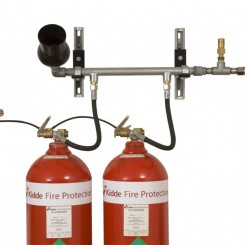Kidde Carbon Dioxide Fire Suppression System (CO2)
The Kidde High Pressure CO2 System utilizes highly sophisticated electric and/or pneumatic detection units which sense fire at its inception. It is designed specifically for each hazard and operated automatically, to ensure immediate detection and rapid suppression of a fire event. HP CO2 Fire Suppression System is an engineered system available in three application configurations: total flooding (for unoccupied areas), local application or hand-hose line. The Kidde Fire Systems carbon dioxide fire suppression system is an engineered, special-hazard system utilizing a fixed pipe and nozzle distribution network, hose reels, or a combination of both. These systems provide fire protection, using carbon dioxide (CO2) as the extinguishant, designed in accordance with the National Fire Protection Association (NFPA) 12, "Standard on Carbon Dioxide Extinguishing Systems". Carbon dioxide is a colorless, odorless, electrically non-conductive gas with a density approximately 50% greater than air. When applied to a fire, it provides a blanket of heavy gas which reduces the oxygen content of the atmosphere to a point in which combustion can not be sustained.
-
The classification of fire is defined as the following:
-
Class A: Surface Type Fires; wood or other cellulose-type material (ordinary combustibles)
-
Class B: Flammable liquids
-
Class C: Energized electrical equipment
-
Class D: Combustible metals (such as magnesium, sodium, zirconium, potassium, and titanium, or reactive metals, metal hydrides and chemicals containing their own oxygen supply)•
-
Class K: Combustible cooking media (vegetable or animal oils and fats)
-
Note: Kidde Fire Systems carbon dioxide fire suppression system is not suited for Class D type of fires. Carbon dioxide is an effective agent for Class A, Class B, Class C, and Class K hazards. Carbon dioxide must be applied with due consideration of the hazard being protected and its contents. Carbon dioxide shall not be used on Class D hazards, such as magnesium, potassium, sodium, and cellulose nitrate. These Class D hazards can only be controlled by special extinguishing agents and procedures.
-
-
General Characteristics of a CO2 system
-
Used for applications where the potential property damage and business interruption from fire are high.
-
Used to control and suppress fires in easily ignitable fast-burning substances such as flammable liquids.
-
Used on fires involving electrically energized equipment.
-
Used on fires in ordinary combustibles such as paper, cloth, and other cellulose materials.
-
- Features:
- Proven quality and reliability with the Kidde brand
- Tested and approved all of Kidde's various detection and control options
- An inexpensive and easy-to-access agent when refill is necessary
- Wide ranges of proven safe, hazard protection
- Technical Specifications:
- Reduces the oxygen content of the atmosphere to a point where combustion becomes impossible
- Hardware to accommodate any application and system type
- Offered in 25 lbs. to 100 lbs. cylinders
- Hose reel line systems
- Directional valve system options
- Lockout valves and lockout circuits
- Applications
- Kidde CO2 Suppression System (Kidde CO2 Sell Sheet)
- Flammable Liquid Storage Areas
- Marine Applications
- Quench and Dip Tanks
- Large Commercial Fryers
- Engine and electrical Rooms
- Spray Booths and paint Lockers
- Turbine Generators
- Printing presses
- Rolling mills
- Dust Collectors
- Industrial ovens
- Mixing operations
- Listing & Approvals:
- FM Approved
- UL Listed
- USCG Approved
- MEA Approved


-
Cable & Pneumatic Actuation:
-
Discharge Accessories:
-
Control Heads:
-
Discharge Heads:












